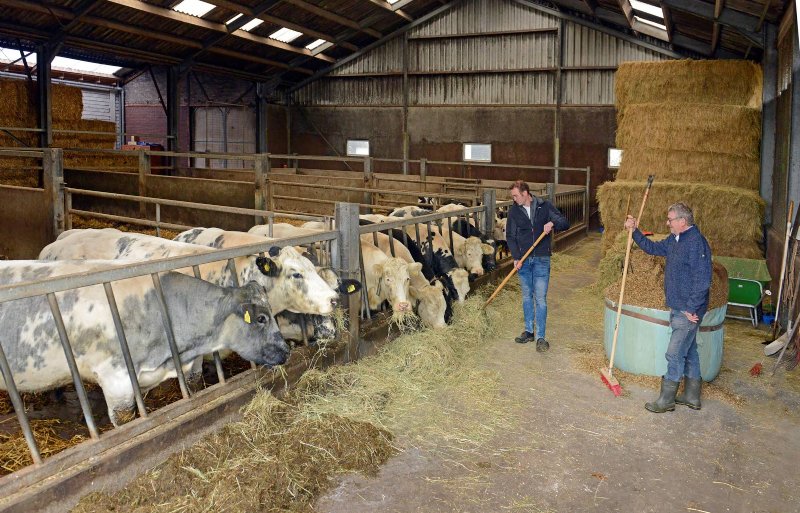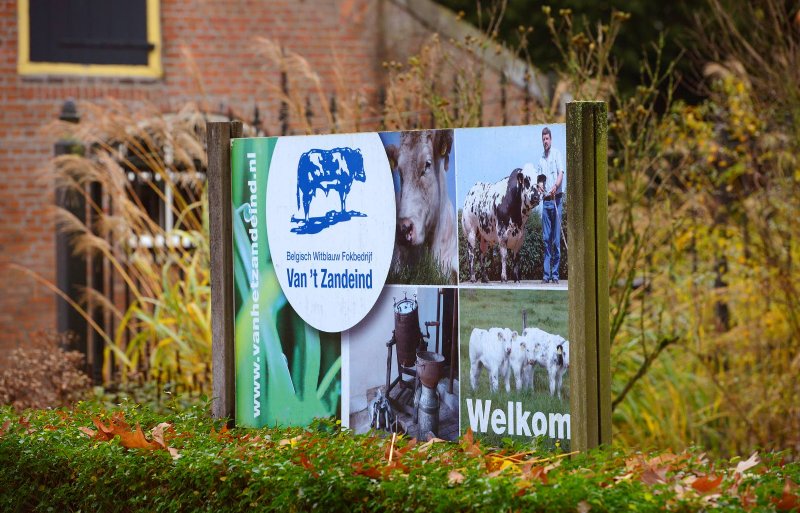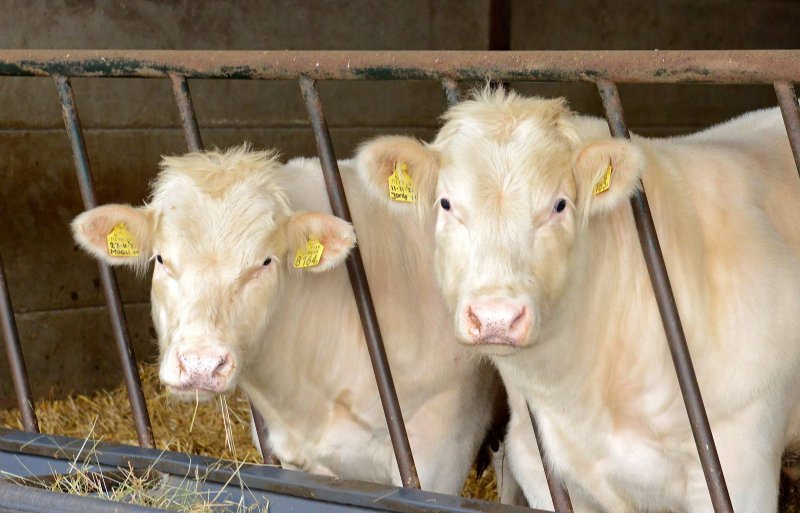Huijbregts wants nothing but the best Belgian Blues for beef ondairy
Jos Huijbregts has been breeding Belgian Blues for almost 35 years. In around 2000, this breed became a popular choice for use on dairy cows as calves with good beef conformation command a higher price. Huijbregts got ahead of the curve and started breeding Belgian Blue bulls for beef on dairy use.

The focus of beef on dairy crossing is short gestation, calving ease and good growth. Huijbregts’ foresight has been a success: semen from Van ‘t Zandeind bulls is exported the world over.
Breeding beef animals is only one of the multiple activities on the Huijbregts family farm in Riel, in
the Dutch province of North Brabant. Jos Huijbregts, his son Joost and daughter-in-law Annelie also
run a care farm, a farm shop, a campsite and provide catering facilities.
However, Huijbregts’ real passion is breeding Belgian Blues. Whether he’s talking about the pair of
young white bulls waiting in a straw pen in the barn to go the AI organisation, or the happy sight of
some pregnant cows and young stock sharing a comfortable pen in one of the other barns: his words
are full of dedication and love for this heavily muscled breed.
“I saw Belgian Blue being crossed with dairy cows and thought: there’s a future in that”
JOS HUIJBREGTS, BEEF FARMER IN RIEL
His love for this beef breed started in the late 1980s. Huijbregts joined the partnership with his father
when he was 20 years old, helping to run the farm that has been in the family for centuries.
‘Back then we had a herd of around 30 dairy cows, not enough to support us all. So, alongside
running the farm, I also worked as an AI technician for 20 years’, says Huijbregts. ‘I saw a lot of things
in the course of those years and realised that what I really wanted to be was a farmer anyway. We
built a free stall barn in 1981. Land was no problem, I could use land owned by friends. But we were
only granted a modest milk quota of just 225,000 litres which is short of what it takes to milk
properly. So we had to think of something else.”
And that was beef cattle. The first cows to arrive at the farm were Limousins, but Huijbregts soon
changed his mind. ‘I had to watch out not be hurt. They had a very feisty character!’ It was a different
story with the Belgian Blues. ‘I first saw the breed in Belgium and it was love at first sight. They’re still
the most docile and cuddly cows we have.”
In the years that followed, the Belgian Blues gradually started replacing the dairy cows in the barns in
Riel. Huijbregts, who had learned to recognised the importance of good bloodlines for breeding
during his career as an AI inseminator, had the opportunity to buy a number of top-ranking Belgian
Blue cows. ‘We flushed embryos from those animals which we then used with the dairy cattle, so
that we quickly had a herd of around 100 and all Belgian Blues.’

The milk quota was sold and Huijbregts continued as a beef farmer. From the mid-1900s, he also participated very successfully in many shows with his Van ‘t Zandeind progeny. He owes much, if not everything, to Galopeur daughter Clarisse van de Roetweijer, who formed the foundation of his successful breeding strategy.
But Huijbregts has also always stayed true to own vision on breeding. ‘I wanted to breed top cows with a lot of weight, length and good legs.
His selections resulted in some good, predominantly white bulls. ‘I thought: they could potentially be
AI material. But then I had to find an AI organisation willing to take them. After all, I’m just Jos, a
simple farmer from Riel and not a renowned breeder from Belgium.’

Gerard Scheepens from K.I. Samen was prepared to give Jos a chance and started offering semen from Remco van ‘t Zandeind (s. Dandy) and Marco van ‘t Zandeind (s. Torrero). Huijbregts is still grateful for opportunity. ‘Those two bulls are where the success story all started and more than 100,000 cows have now been inseminated with semen from those sires.”
Two breeding goals
Since then, Huijbregts has followed two breeding goals in his Belgian Blue herd: breeding bulls
destined for beef on dairy purposes from some lines and trying to produce the best animals that
meet the ideal breed standard from other lines. The attends many shows with these animals.
The lines mainly from originate from the Clarisse line, but with the bulls for beef on dairy he
specifically examines a number of traits. ‘For example, a short gestation time. It’s an advantage if the
gestation length can be reduced by a week. This not only makes calving easier as the calf weighs a
little less, it also means you can milk the cow for a week longer.’
Calving ease in another priority. ‘I pay attention to making sure my sires produce lighter weight
calves, which are calved easily and preferably without assistance. In fact, I never hear that cows
inseminated by my bulls need a caesarean section at calving.’
Dutch Belted and Herefords
Huijbregts speaks from his own experience. Many Belgian Blue calves have been born naturally from
his dairy cows and even from Dutch Belted, another breed kept on the farm. Just like the Herefords.
Despite the somewhat lighter birth weight, the beef on dairy calves quickly start to become more
muscled. ‘The calves are vital at birth and drink well, so they develop quickly and in the right way for
fattening.’ The stand-out feature of the breeding bulls is probably their colour. They are all white. ‘If
you inseminate dairy cows with their semen, the calves have a blue roan coat. That’s what dairy
farmers like, they prefer not to have black calves.’
Since Remco and Marco Van ‘t Zandeind, the bull chart at K.I. Samen has featured many names of
Belgian Blue sires bred by Huijbregts. There are currently four on offer: Jordy van ‘t Zandeind (v.
Brasero Du Moligna, out of Clarisse 105 van ‘t Zandeind), his zon Joppe van ‘t Zandeind (out of
Clarisse 107 van ‘t Zandeind), Dries van ‘t Zandeind (s. Davey, out of Clarisse 109 van ‘t Zandeind) and
Björn van ‘t Zandeind (s. Bruno van de Plashoeve, with the same dam as Joppe).
Sensational semen sales
‘Sales of Jordi’s semen are absolutely sensational. He can barely cope with the demand. So one of his
sons will shorty become available too, Joppe. And another son of Jordi is also in line to go to the AI
station.’ This is Jort van ‘t Zandeind (out of Coldita 32 van ‘t Zandeind, another breeding line on the
Huijbregts farm).
At the time of the interview, he was one of the young bulls waiting amicably in the barn with his
colleague Moos van ‘t Zandeind (s. Merkel’s Mogli out of Clarisse 124 van ‘t Zandeind) to be taken to
the AI organisation.
Good small calves
‘They are all interesting bulls for beef on dairy. I’m convinced that Jordy, like Remco before him, will
turn out to be a real star. But it also depends on precisely what the dairy farmer wants. For example,
Dries produces slightly heavier calves and Björn’s dam was registered in the herdbook with almost 90
points and ultimately gave a carcass weight of 625 kilos. Mogli, the sire of Moos, is known in
Germany to produce good small calves’, explains Huijbregts.
‘I sometimes hear that dairy farmers are reluctant to use Belgian Blue bulls on their dairy herd, but
there’s really no need for any concerns’, the breeder emphasises.
From 100 to 40
Whereas there were once around 100 Belgian Blues on the farm, the herd now numbers around 40.
Two-thirds of these are for pure breeding for shows, and one-third is used to breed bulls intended for
beef on dairy crossing. Huijbregts also keeps Dutch Belted, Herefords and a few white-headed
Groningen Blaarkoppen. In the season these animals graze on herb-rich grassland on an estate close
to the farm and are not fed any concentrate. ‘It’s all pure nature’, says Huijbregts.
Natural meat
This meat is marketed as natural meat in the farm shop operated by the family. The wide
diversification on the farm means the family benefits from an EU subsidy for keeping rare farm
animal breeds, and generates a good income from selling their own produce direct to the public. ‘You
have to see and take advantage of business opportunities’, is how Huijbregts puts it. ‘Just like almost
25 years when I first saw Belgian Blue beef on dairy crosses. I immediately thought: there’s a future
in that!’
DETAILS
Name: Jos Huijbregts
Place: Riel (North Brabant)
Farm: Van ’t Zandeind
Size: 30 hectares around farm, 60 hectares of nature habitat.
Huijbregts runs the farm in partnership with son Joost and daughter-in-law Annelie. They have a care
farm, a farm shop to sell their produce, a campsite and a beef herd of 40 Belgian Blues, 50 Dutch
Belted, 25 Herefords and four Groningen Blaarkoppen.






